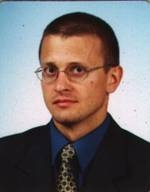Invited Speakers
- March 4th, 2023
- Prof. Daswin De Silva, La Trobe University, Australia
- March 5th, 2023
- Prof. Krzysztof Szabat, Wroclaw University of Science and Technology, Poland

Prof. Daswin De Silva
Daswin De Silva (PhD, SMIEEE) is the Deputy Director of the Centre for Data Analytics and Cognition (CDAC) at La Trobe University, Australia. He is also an Honorary Adjunct of the Department of Computer Science, Electrical and Space Engineering, at Lulea University of Technology, Sweden. His expertise is in Artificial Intelligence (AI), Automation, Analytics and the Ethics of AI, Data and Machines. He received national recognition for teaching excellence in Artificial Intelligence, with the citation, "Unravelling Artificial Intelligence – Development of curricula with real-world cases that deconstruct the technical complexities, practical applications and ethical implications of Artificial Intelligence" at the Australian Awards for University Teaching (AAUT) 2021. He also received the Vice-Chancellor’s Award for Teaching in 2019 and the Vice-Chancellor’s Award for Mid-Career Research Excellence in 2018. He has co-authored 120+ research articles with an average impact factor of 6.1 (max impact factor 14.1). From 2018-2022, he has been Lead CI, Co-CI, AI of AU$ 10.9 million funding (max as lead CI $900k) for research and application of AI and automation innovations. He has supervised eight doctoral candidates to completion, and currently supervises ten CDAC PhD candidates who are working on theoretical, applied and industry topics of AI and Automation. He is an Associate Editor of the following four journals, 1) IEEE Transactions on Industrial Informatics, 2) PLOS One, 3) IEEE Open Journal of the Industrial Electronics Society and 4) Springer Discover AI. He was the Lead General Chair of the 15th IEEE International Conference on Human System Interaction - HSI 2022, Melbourne, Australia, 28-31 July 2022. He is a Program Co-Chair of the 24th IEEE International Conference on Industrial Technology, Orlando FL, USA, 4-6 April 2023. Daswin is a Senior Member of the IEEE, where he holds the following three offices, 1) Chair of the Web and Information Committee (reporting to IES President-Elect), 2) Chair of the Technical Committee on Big Data and Machine Learning, and 3) Chair of the Technical Committee on Technology, Ethics and Society. He is a permanent Chair of technical tracks in AI, Analytics and Automation in the following international IEEE conferences: Industrial Informatics (INDIN), Emerging Technologies and Factory Automation (ETFA), Industrial Electronics (IECON), Industrial Technology (ICIT) and Industrial Symposium (ISIE).
Advancing Artificial General Intelligence for Applied Abstraction and Integrated Design
10:50~11:50, March 4th, 2023 @ Symposium Space, Raiosha, Keio Univ.
The early indicators of Artificial General Intelligence (AGI) emerging from amidst the expedient development and adoption of Artificial Narrow Intelligence (ANI) are substantiating a paradigm shift across all disciplines of research. Manifesting as large pretrained models with adaptive capabilities for finetuning, few-shot learning, contrastive learning, embedded multimodality and generative conversation, AGI is rapidly transitioning from research prototypes into commercialised microservices, such as ChatGPT, DALLE, Gato. However, these recent successes characterise an ‘intelligence without knowledge, reasoning, or the notion of truth’. Besides, the human brain operates at a fraction of the computing, data and energy footprint consumed by such large AGI models. In this keynote address, I will introduce a novel, cognitive approach for building AGI that is grounded in the architectures of vectors and symbols, enabling learning to reasoning, and other high-order cognitive functions. Following an overview of the foundational fields of this cognitive approach, Vector Symbolic Architectures, Sparse Representations, and Spiking Neural Networks, I will present our recent work on the design and development of two new algorithms, Hyperseed and Hyperbase, focusing on simplicity of structure that orchestrates complexity of intelligent function. This simple to complex dynamics are representative of integrated system design that solidifies the notions of applied abstraction between science and engineering. Deliberations of the trifecta of AI, Automation and Analytics in integrated system design across diverse applications, and its implications for applied abstraction will be followed by concluding remarks on the future directions of AGI research for applied abstraction and integrated design.

Prof. Krzysztof Szabat
Krzysztof Szabat received the Ph.D. and D.Sc. degrees from the Electrical Engineering Faculty of Wroclaw University of Technology, Wroclaw, Poland, in 2003 and 2008, respectively. In 2016 he was awarded with the title Professor of Technical Sciences. Currently he is Head of the Department of Electrical Machines, Drives and Measurements at Wroclaw University of Science and Technology. He is the author and coauthor of over 100 journal and conference papers. His main field of interest is the application of the control theory, artificial intelligence methods, and microprocessor techniques to motion control. Prof. Szabat had scientific/didactic stays in the universities in Germany, Ireland, UK, Croatia and Russia.
Damping of the torsional vibrations using classical and novel control algorithms
14:20~15:20, March 5th, 2023 @ Symposium Space, Raiosha, Keio Univ.
Industrial automation is mainly based on the electrical servo systems. Faster operation increase the productivity of technological lines which is obtained by designing systems with shorter responses of the speed/position. There are two general ways of modification the standard drive resulting in better dynamics. The first one is to use lighter structures with smaller inertia, while the increase of gains of industrial controllers can be treated as a second option. However, both options may excite torsional vibrations, limiting the efficiency of modern systems. Originally, torsional vibrations had been described in traditional big drives used in industry, such as rolling-mill drives, conveyer-belt drives and machines used in textile and paper industries. Nowadays, a similar problem is recognized also in modern applications, i.e., deep space antenna drives, wind mills, robot arm drive, servodrives, and even in MEMS.
In the presentation, the most important control structures used for vibration damping will be presented and characterized. The presentation will include both classical and novel structures. Estimators of state variables and parameters required to implement control structures will also be included.